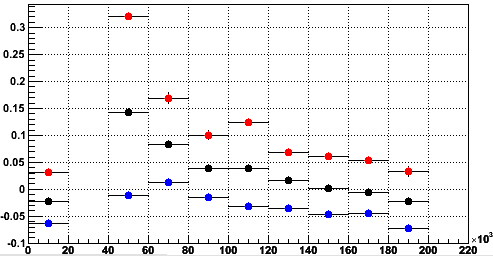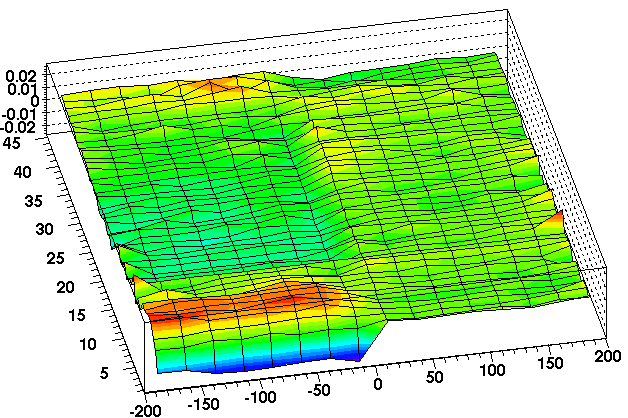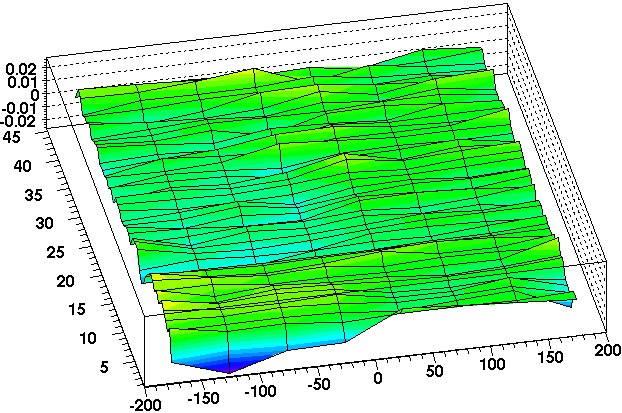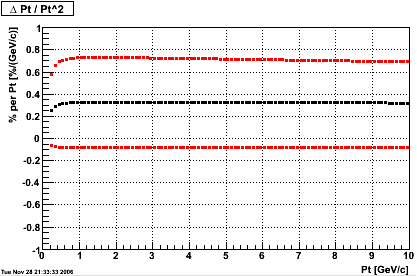computing
Clustering
Updated on Fri, 2007-10-19 14:59. Originally created by kocolosk on 2006-11-30 15:50. Under:Second most important step in EMC data reduction is to find clusters from EMC data.
Main code performing EMC clustering is located in StRoot/StPreEclMaker and StRoot/StEpcMaker
StBSMDStatusMaker
Updated on Fri, 2007-10-19 12:39. Originally created by kocolosk on 2006-11-30 14:13. Under:This page gives a brief overview of the code Frank Simon developed to create SMD Status Tables from MuDSTs.
trash
Updated on Thu, 2006-11-30 12:15. Originally created by balewski on 2006-11-30 12:10. Under:Online Work
Updated on Wed, 2007-03-21 09:04. Originally created by kocolosk on 2006-11-29 17:38. Under:http://www.star.bnl.gov/protected/spin/trent/calibration/calibration.html
pp62 (2006)
Updated on Thu, 2006-11-30 11:53. Originally created by genevb on 2006-11-29 11:36. Under:
Signed DCA
Signed DCA profile versus BBC sum (east+west), where the red markers are from using east-TPC-only tracks, blue is west-TPC-only, and black is all tracks combined:Some observations:
- The lowest luminosity bin does not fit the pattern of the higher luminosity data (it seems to have only small distortions, which is what we would like to see!).
- For the rest, there appears to be some luminosity dependence, and it goes it the correct direction for this field (negative slope for positive field).
- The east and west TPC are offset from each other. My first guess on this was that the Field Cage Shorts wasn't doing it's job so well on the east, and this was causing a shifted sDCA. But other east-west differences show up (see the next section) which hint that the shorted ring may not be the problem.
- The overall effects are small, with sDCA values generally of a few hundred microns. A plot of the track-by-track sDCA can be found here, and I estimate that overall the sDCA is offset from zero by about 300-400 microns, with an RMS of about 500 microns (due to the luminosity range).
Residuals
Global track residuals at low (left, BBC sum < 1e5) and high (right, BBC sum > 1.5e5) luminosities versus Z and padrow:Key points:
- These distortions are quite small, producing residuals in the range of 100-200 microns.
- There is a notable east-west difference, and the distortions appear to be almost non-existent in the west. Some east-west differences have been observed in the past, but were atop a much larger distortion, and were considered not worth worrying about.
- Almost no z-dependence is at odds with our correction model.
- The high luminosity data appears less distorted than the low luminosity (which agrees with the sDCA plots above). Could it really be that what I am labeling as low luminosity (low BBC sum rate) is actually more distorted? Perhaps some backgrounds existed during the periods of low luminosity data, which went away during the periods of higher luminosity (which tended to be earlier during the 62 GeV running).
Summary
First, it is worthwhile to note that our ionization distortion correction machinery is not set up for east/west differences. Using a sagitta error of 400+/-500 microns, here is the estimated error in transverse momentum reconstruction of primary tracks, in delta Pt / Pt^2 (fractional momentum error per GeV/c of momentum):We can see that we expect something like an error pf 0.33% per GeV/c of Pt. This corresponds to an average error of 3 MeV/c on a Pt = 1 GeV/c track, and about 85 MeV/c on a 5 GeV/c track (with fluctuations of about +/-100 MeV/c from the mean). There are less than 20 million events with TPC information in this pp62 dataset (mostly the "mb" trigger). This will statistically limit any analyis from high-pt studies, precluding the need to have the data calibrated to higher precision than already exists in this uncorrected data.
Gain Stability Check
Updated on Wed, 2007-04-25 12:41. Originally created by kocolosk on 2006-11-28 22:01. Under:Existing generic accounts
Detector Upgrades
Updated on Sat, 2006-11-18 23:17. Originally created by testadmin on 2006-11-18 23:15. Under:This Drupal section is reserved for R&D detectors. Each detector would
be moved to the root area whenever ready.
Tracking Review Committee Charge
Updated on Sat, 2006-11-18 23:34. Originally created by andrewar on 2006-11-18 20:20. Under:Tracking Upgrade Review Material
Updated on Fri, 2007-01-05 13:17. Originally created by andrewar on 2006-11-18 20:13. Under:VMC C++ Classes
Updated on Wed, 2006-11-08 18:51. Originally created by potekhin on 2006-11-08 10:46. Under:StarVMC/StarVMCApplication:
- StMCHitDescriptor
- StarMCHits
- Step
- StarMCSimplePrimaryGenerator
Example of setting the input file: StBFChain::ProcessLine ((StVMCMaker *) 0xaeab6f0)->SetInputFile("/star/simu/simu/gstardata/evgenRoot/evgen.3.root");
Expert Operation
Updated on Mon, 2006-11-06 11:19. Originally created by kocolosk on 2006-11-06 10:22. Under:- default.ini
This is the basic configuration file. In this file there is information about the high voltage database file, which box and CW-Base need to be turned on, serial line settings and other configuration stuff. This file do not need to be edited by hand. There is a special window in the high voltage program that can be used to modify this file.
Reprogram Individual Crate
Updated on Mon, 2006-11-06 08:42. Originally created by kocolosk on 2006-11-06 08:42. Under:Expert Operation
Updated on Mon, 2006-11-06 08:40. Originally created by kocolosk on 2006-11-06 08:25. Under:
There are a few commands for expert operation. They are:
-
Led Ampl. entry box
This Configures the LED pulser amplitude. Enter the value and press [Set] to set it for all the tower crates
Expert Contacts
Updated on Mon, 2019-06-17 08:22 by testadmin. Originally created by kocolosk on 2006-11-06 08:10. Under:Phone: x1038 (BNL) or (323) 610-4724 (cell)
Oleg Tsai (on site all run) e-mail: tsai@physics.ucla.edu
BSMD
Updated on Mon, 2006-11-06 11:47. Originally created by kocolosk on 2006-11-06 08:01. Under:SMD High Voltage Operation Manual
Version 1.00
11/12/03, O.D.Tsai
Overview
BTOW
Updated on Mon, 2006-11-06 10:37. Originally created by kocolosk on 2006-11-06 08:00. Under:This program is designed to control the high voltage of towers PMT's (Photo Multiplier Tubes). Each tube has an independent high voltage settings. Each PMT is connect to a CW-Base that controls the high voltage for the base. The CW-Base connects to a personal computer running Windows through a RS-485 serial line. The personal computer runs a LabView program that communicates to all CW-Bases in the system to set and monitor the high voltage on each PMT.
Grid meeting
Updated on Thu, 2006-11-02 14:33. Originally created by jeromel on 2006-11-02 13:59. Under:, at 00:00 (GMT), duration : 00:00
- Grid operation meeting summary - Wayne
- Site status - All
BNL
SPU
WSU
BHAM
UIC
- SUMS new configuration, status/progress report - Leve
- If we have time
* BHAM and SRM, could Eric help setting the same framework?
* VDT and AFS, status
* STAR plan progress - statement and interest from remote site
meeting info: 6PM UK, 1 PM EST/EDT, 12 PM CDT, 10 AM PDT or in room 1-189 and/or
+ Phone: 8383 (+1-631-344-8383).
+ VRVS Subway room (Community=Transport/Universe)




